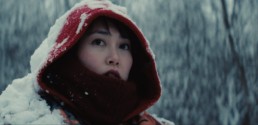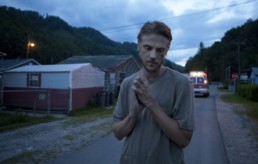Review: 'Kumiko, The Treasure Hunter'
Human beings sometimes take for granted the gift of communication. In a world so enveloped in its own social media and online dating, the idea of isolation becomes both terrifying and obscure. It is sometimes difficult to define this type of loneliness as it transcends the physical and the technological barriers of existence.
In the Zellner Brothers’ Kumiko, the Treasure Hunter, this isolation is displayed on the screen in all its darkly humorous glory, as Kumiko (Rinko Kikuchi) faces two obstacles that trap her within the bonds of seclusion: a language barrier in the United States, and social awkwardness amongst her peers and family in Japan. All of this she finds on her journey from Tokyo to the American mid-west, to seek out a treasure that she has discovered by deciphering clues within a strange and mysterious film (a copy of the Coen Brother’s 1996 classic, Fargo).
The film is shot in two very different regions, as half the film takes place in the very urban and tradition-bound Tokyo, and the other in various snowy Minnesota locales. Director David Zellner explains that shooting in these two settings was crucial in that “the different landscapes and environments and cultures are almost like secondary characters in the film.” This allows for an even greater feeling of empathy and appreciation for Kumiko’s isolation, in that even the world around her rejects her.
Her futile and feeble struggles to maintain some small form of conformity within her world, such as half-hearted attempts at social interactions at work and with her family, are heartbreaking because they remind us of the times we have found ourselves without any control of our lives. We recognize the familiar feeling that we must do what is expected of us, not what is always expected by us.
The filmmakers challenge audiences to release their expectations of what real life is, and if audiences successfully reach this state of hope upon conclusion, then the ending greets them like a cheering crowd at a finish line.
The Zellner’s continue to use themes of isolation within their very specific choices of color. The choice is made very early on that, Kumiko, being the fantastic factor of the narrative, has a color score of a hot-rod red hooded jacket to reflect that. This bright red “eye magnet” stands strong against the brown and gold color pallet of Tokyo, and the 50-plus shades of white that seems to constantly envelope the American mid-west. This choice of bold color symbolism as a motif that doesn’t play games with the viewer’s head and makes a clear distinction as to its intention, which has all but disappeared from more recent films. However, in this piece, the filmmakers have enough courage to trust the simplicity of their chromatic distinction.
As a result, they preserved a constant reminder throughout the film that, Kumiko, the girl in red, is unique and stands out from her surroundings–and so it is her story that is being told.
To tell the story of Kumiko, the perfect decision was its casting in Rinko Kikuchi. It is sometimes very difficult as an American to appreciate the struggle of being unable to communicate through language because of our relative national seclusion (we are one of three countries that make up our continent and most of us tend not to get out much). Kikuchi’s performance, which garnered an Independent Spirit Award Nomination this year for Best Leading Actress, was so touching that it makes audiences want and yearn for the impossible if it means that Kumiko finds her treasure. It is very rare, especially in such a heavily depressed and emotionally sedated character, to command such undivided attention from its audience. However, with great entertaining force, audiences find that Kikuchi is earnest enough to make us laugh and genuine enough to make us cry.
The part that really sells the film (not that it needs to be), resides in its very wonderful ending. Without giving too much away, the narrative resolves itself with a lovely dose of existential surrealist symbolism. As with Iñárritu's Best Picture Winner, Birdman: Or the Unexpected Virtue of Ignorance and Scorsese's Taxi Driver, audiences must make their own interpretation as to the conclusion of the narrative. However, it is very clear based off of the choices by the filmmakers that the goal of their story is to entice audiences into hoping for the impossible. With this ending, the filmmakers challenge audiences to release their expectations of what real life is, and if audiences successfully reach this state of hope upon conclusion, then the ending greets them like a cheering crowd at a finish line.
And so, Kumiko, the Treasure Hunter's ending effectively serves as a perfect example of the film’s purpose, to ask the viewer to question the lines between both the mundane and the fantastic, between expectations and possibilities. If the Zellner Brothers continue to challenge these lines within their films, then it is safe to expect and enjoy imagining the possibilities of more big things coming from this independent cinematic duo.
Kumiko, the Treasure Hunter opens in LA this Friday.
https://www.youtube.com/watch?v=5TnVbcEQJrE
Review: 'Little Accidents'
Everyone has heard of the ripple effect. The micro influencing the macro, or the butterfly effect; through some channel of learning, most of the general public has come to understand these theories of life. This perception of compound influences is transposed onto the internal struggles with morality of members of a little community in the heart of Americana in Sara Colangelo’s writing and directorial debut, Little Accidents.
The film juxtaposes a survivor of a coal mining accident named Amos (Boyd Holbrook) with Owen (Jacob Lofland), a son of one of the deceased miners involved in the accident. The audience is informed early on, with some overly expository dialogue, that Amos is faced with the obstacle of truth in his testimony of what happened in the events leading up to the accident. What makes this testimony so important is that it decides the fate of the entire community that has developed around the coal mine. He must decide between truth and what is best for everyone. Of course, the community attempts to help him make that decision through peer pressure and other methods.
While this is occurring, Owen finds himself in a similar crossroad between truth and what is best for him after accidently killing another boy. The deceased boy just happens to be the son of Diane (Elizabeth Banks) and Bill Doyle (Josh Lucas), the man who is being held chiefly responsible for the accident that killed 10 miners, including Owen’s father. This event will lead to the downfall of the Doyle family that reflects the crumbling sense of community. Once again this goes back to the ripple effect of little accidents leading to bigger effects.
This is [Jacob Lofland's] second major film following the critically acclaimed Mud back in 2012, and in both performances he has delivered characters with honesty and the genuineness of a seasoned actor.
When watching the film, there are some excellent sparks of future promise. Firstly, Rachel Morrison’s cinematography shows a great deal of potential, especially considering this is her first major feature following a few years of experience in documentaries and television work. She adopts an almost Malick-esque respect for the nature surrounding the story. In addition, she pays so much attention to the decaying and rusting setting filled with old trailer homes, abandoned train tracks and chain link fences that it adds to that sense of a dying community. The camera work also brings more attention to the class differences between characters that is brought up early on in the film, but then is seemingly forgotten in the story, with the exception of Morrison’s camera’s memory.
Another person involved in the film that deserves some attention in future endeavors is young Jacob Lofland. This is his second major film following the critically acclaimed Mud back in 2012, and in both performances he has delivered characters with honesty and the genuineness of a seasoned actor. While his character in Mud was more the funny best friend of the protagonist, he demonstrates excellent range and pathos in Owen, a boy dealing with more guilt than he can handle until he breaks. His portrayal causes audiences to feel compassion for the scared child that is trying to cope with the pain of responsibility for his mistake.
Speaking of mistakes, it’s time for a few cons. Pacing was not a strong suit of the storyline. Characters seemed to develop very rapidly but not with proper reason or cause. For example, the relationship between Amos and Diane seems to read like this: she has a break down at a bible study, he gives her a ride home, they both can’t sleep and so they sleep with each other. It seems to run very quickly to adultery and while there are signs later on that the Doyle’s marriage wasn’t exactly perfect, it’s too difficult to really understand if this is because of their son’s disappearance or something that had been going on for a long time.
On the other side of pacing, the second act was painfully slow and felt as if it was simply re-establishing guilt without any development from the characters. Perhaps this was done intentionally to show a stand-still in the character’s lives due to guilt, but it takes away from the established theme of the micro affecting the macro. However pacing is one of the most difficult aspects of storytelling, and as Colangelo develops as a filmmaker, she should be able to avoid such droughts in plot and character development.
Little Accidents challenges the viewer to think about the difference between right and wrong. Just how subjective is morality and is it always so black and white? Is the truth always the right course of action? The truth is, while the film leaves something to be desired, it is a product of a relatively inexperienced crew and cast that showcases talents and functions well as a starting point. Now it is just a matter of waiting to see if those involved develop, or if the good qualities of the film were just little accidents.
https://www.youtube.com/watch?v=5PrTTsvs05U


